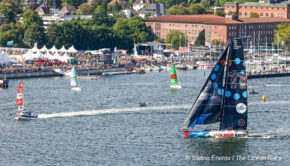Questions asked about Volvo Ocean Race accident
Published on November 30th, 2014
Team Vestas Wind may likely have concluded their Volvo Ocean Race campaign when their boat was grounded on the Cargados Carajos Shoals in the Indian Ocean on Saturday night, November 29. With both rudders broken and water ingress into the stern compartment, it was a grim moment for skipper Chris Nicholson and his team.
Sitting high on the reef, the crew waited until daylight, then stepped off the boat onto the reef, later to be transferred to a local rescue boat. Now they will stay on nearby Íle du Sud today (Nov. 30), with plans to return to the boat on Monday to remove gear and travel on Tuesday to Mauritius (Dec. 2). Click here for the incident report.
Two questions are being asked. Where is Cargados Carajos Shoals and how can a professional team have this kind of accident?
Cargados Carajos is a group of long lying islands that are .8 square miles in area, with surrounding coral reefs. They are inhabited and belong to Mauritius, an island nation 270 miles to the southwest. Mauritius is about 1,200 miles off the southeast coast of the African continent.
As to why Vestas Wind ran aground, Vestas Chief Marketing Officer Morten Albæk is delaying comment. “The root cause of the accident is now under investigation. (However) we obviously hope to stay in the race.”
A team led by the Vestas shore crew is now en route to Mauritius to further assess the damage to the boat.
Abu Dhabi Ocean Racing skipper Ian Walker was not surprised by the incident. “When we went past there we actually said how easy it would be to hit it at night. Fortunately we went through there in the daylight. It is very difficult to see it with the electronic charts, and of course at night you wouldn’t see it at all.”
Team Alvimedica, which had been near Vestas Wind at the time of the incident, was equally concerned about safely navigating through the area. “We had been talking about these reefs for some time, so we were already pretty nervous about it,” noted navigator Will Oxley.
Dongfeng Race Team reporter Yann Riou notes how they also had the Cargados Carajos Shoals directly in their path. “Skipper Charles Caudrelier had noticed this archipelago a few days earlier, but it’s worth noting that it’s actually pretty hard to find. In fact, to see it on our electronic charts, you have to zoom right in on top of it. But how and why would you zoom into it if you don’t know it’s there in the first place? So whilst we don’t know exactly what happened on Vestas, we can imagine how it happened.”
After analyzing the early information from afar, marine industry consultant and professional navigator Campbell Field provides his opinion on the incident…
“Since Vestas Wind grounding there has been a huge amount of speculation and opinion as to how this happened, or who is to blame.
“I don’t know 100% about other software packages, but Expedition routing can route freely (i.e. with no obstacles) or can be constrained by charts, or your own marks, or your own prohibited zones. Plenty of optimal route outputs run where you would have to put the wheels down. Ultimately, it is the user who defines how the routing output is run and results used.
“The point I’m putting forward here is that software does not make someone a navigator. First you must be a navigator, and then know and understand the strengths and limitations of the tools you have.
“When this is explained to a lot of people I meet, it is usually met with confused stares. The number of software jockeys (promoting themselves navigators) in yacht racing I have come across, who expect the answers to fall out of their computer, is astounding. Take the deck screen away from them and they couldn’t get out of the marina or find the top mark efficiently if their life depended on it.
“Vestas Wind navigator Wouter Verbraak is one of the best, and firmly falls into the category of a superb yachtsman and navigator. He is one who understands the strengths and limitations of digital tools more than most will ever do. And one of the nicest guys in the sport to boot.
“Mistakes happen. Just glad they are all safe and uninjured.”
Race website – Tracking – Watch log – Videos
Background: The 2014-15 Volvo Ocean Race began in Alicante, Spain on Oct. 11 with the final finish on June 27 in Gothenburg, Sweden. Racing the new one design Volvo Ocean 65, seven teams will be scoring points in 9 offshore legs to determine the overall Volvo Ocean Race winner. Additionally, the teams will compete in 10 In-Port races at each stopover for a separate competition – the Volvo Ocean Race In-Port Series. The second offshore leg from Cape Town, SA to Abu Dhabi, UAE is 6,125 nm, started Nov. 19 with an ETA of Dec. 9-16.









 We’ll keep your information safe.
We’ll keep your information safe.